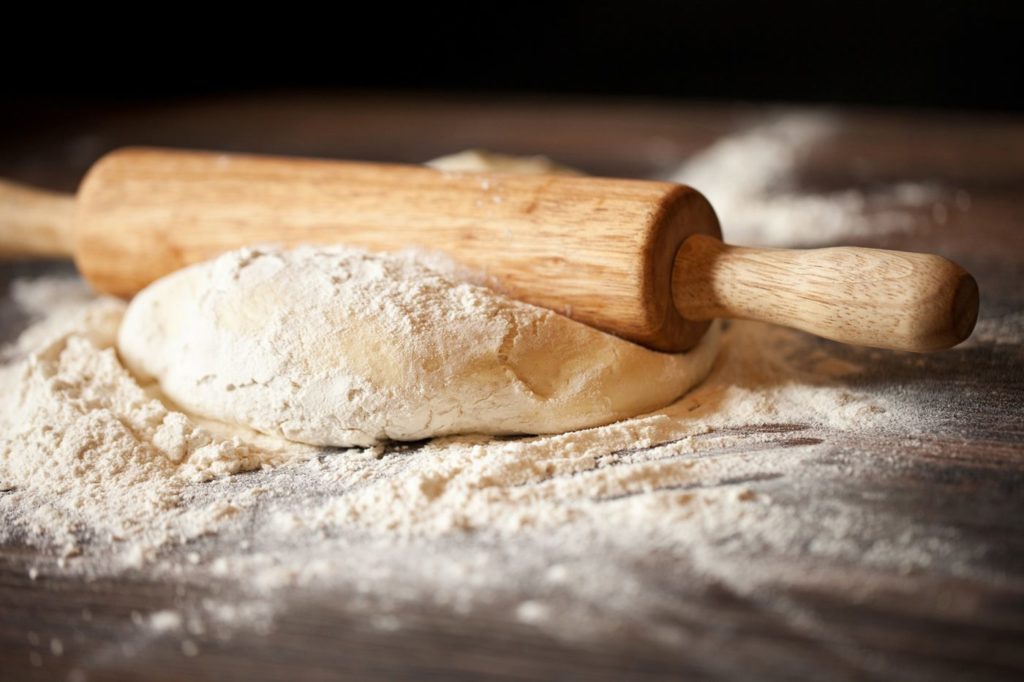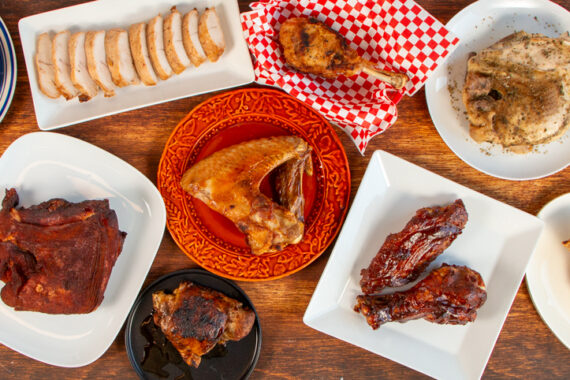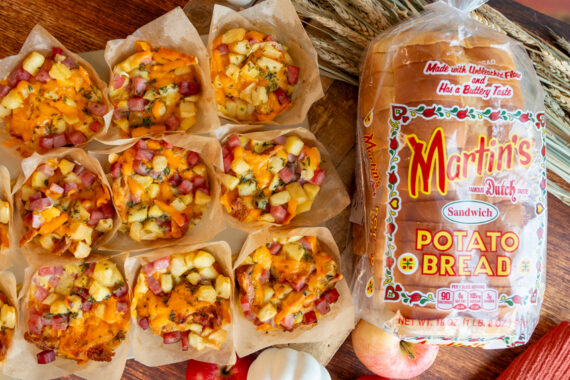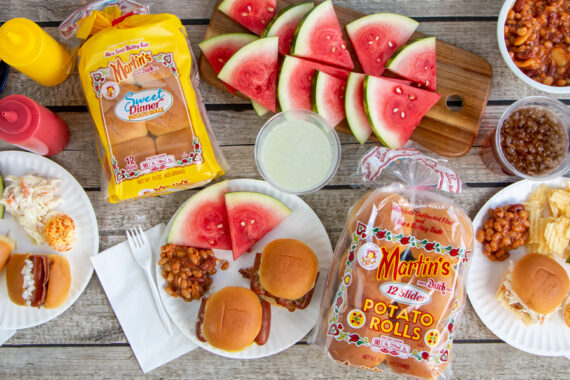
Baking bread is truly a science. Everything from the temperature and humidity, to the length of time in the oven, to the ratio of ingredients to one another has an effect on the final outcome. With curious terminology like “proofing” and “fermentation,” it takes an expert to understand and fully appreciate the beauty behind the science.
That’s why we sat down with our Product & Quality-Assurance Manager to ask her for some insight into the baking process and the science behind Martin’s bread and rolls. Enjoy the following brief overview of the “science of baking,” along with some answers to frequently asked questions about Martin’s Famous Potato Rolls and Bread.
A Brief Overview of the Baking Process
Among the essential ingredients for baking bread are flour, yeast, sugar, fat (e.g., butter or oil), and liquid (e.g., water or milk). These ingredients work together in an intricate way to form bread: sugar “feeds” the yeast and helps it to rise, fats help to tenderize the dough, and so on. The ratio of these ingredients to one another is a bit like a mathematics equation; a small change in one variable can cause a much different outcome.
After the ingredients are mixed together, the dough undergoes several different steps before it can be baked into bread. One of these steps is kneading, which helps to expel the excess air out of the dough to achieve a soft and uniform texture in the product.
Another very important step is fermentation, including the process of proofing, which is when the dough rises. Yeast is the catalyst of the fermentation process. During this process, the dough is rising to the correct shape, and the flavor, aroma, and texture of the product also start to develop. As heat and humidity are added to the process in the proofer, the yeast reacts with the sugars and starches to produce CO2, which is what causes the rolls to rise and transition from pieces of dough to risen, unbaked rolls.
The baking process then introduces greater heat to the dough via the oven, which at first causes the yeast to become even more active, causing what is known as “oven spring,” which is when the dough expands a bit more into its “loaf” or “roll shape.” The heat eventually kills the yeast and the loaf begins to “set.”
If you’re interested in a more extensive discussion of how bread is made and what happens on the molecular level (it’s actually quite interesting!), there are numerous sites online that explain it in detail. For now, we will move on to some specific questions people have asked us about our products.
What kind of fat (e.g., oil, butter) does Martin’s use?
Martin’s uses sunflower oil and butter in our bakery products. The butter contributes to the slightly buttery taste of our products, particularly in the case of our Old-Fashioned Real Butter Bread, which uses only butter without any additional oils. The sunflower oil in our other products acts as a shortening agent. It is responsible for the tender “eating quality” of our rolls.
Does Martin’s use sugar in their bread and roll products?
Yes, Martin’s uses real cane sugar in all of our products. Sugar provides a source of food for the yeast during the fermentation process, and, along with the milk and potato flour, also gives our products their slightly sweet flavor.
What exactly is a “potato roll”?
A potato roll is a Pennsylvania Dutch tradition that replaces a portion of wheat flour with potato flour, which gives it a soft and sweeter taste and texture than normal white rolls. Potato flour is made from potatoes that are dehydrated and milled into granules or flakes.
Are all of Martin’s products made with potato flour?
Martin’s uses potato flour (in addition to wheat flour) in all but three of our products. Big Marty’s Rolls, Hoagie Rolls, and Old-Fashioned Real Butter Bread do not contain any potato flour, but still contain our other high-quality, non-GMO ingredients.
All of our other products, including the popular Sandwich Potato Rolls (burger buns) and Long Potato Rolls (hotdog buns), are made with potato flour and high protein, unbleached, enriched wheat flour.
Included in our list of products that contain potato flour is Martin’s whole wheat product: 100% Whole Wheat Potato Bread. This is made with 100% stone-ground whole wheat flour in addition to the potato flour.
What makes Martin’s products different from other bread and roll products?
In addition to the use of potato flour, Martin’s bakery sources non-GMO, high-quality ingredients including high protein wheat flour, real butter, milk, and cane sugar.
We believe that what we put into our products is just as important as what we don’t put into them. Thus, we don’t use any artificial color or sweetener in our products, nor do our products contain any soy. We also take pride in making sure our product is as fresh as possible when it enters the market.
Along with the use of high-quality ingredients, we monitor our production to make sure our ingredients and processing meet strict specifications to ensure a consistent quality to our customers. These are a few of the reasons why Martin’s bread and rolls are so soft and pillowy!
Why do Martin’s products last so long?
Martin’s prides itself in the freshness of our rolls on grocery store shelves. We produce to order and have our rolls to the grocery stores very quickly. We only leave them on store shelves for a few days (unlike many commercial bakeries that leave theirs on the store shelf for a week or more) to ensure that our customers are getting the freshest, best-tasting product possible.
Martin’s also works hard to keep our bakery as clean as possible (which includes using an air filtration system), which helps to reduce mold spores. It’s commonly known that mold spores are everywhere in the air around us, and mold begets more mold (which is why you should regularly clean out your bread drawer, especially if something in there was moldy). Thus, the cleaner we can keep the bakery, the fewer mold spores are around to affect the bread and rolls.
Additionally, Martin’s uses calcium propionate to assist in the shelf life of the rolls for the consumer. Calcium propionate is a substance that occurs naturally in fermented foods (like beer) and mature cheeses (such as Swiss cheese), and when added to bread it inhibits mold growth.
What makes Martin’s rolls their signature golden color?
Martin’s uses natural Annatto and Turmeric for our golden color. Turmeric is extracted from the turmeric root. Annatto is derived from the seeds of the achiote tree. Both have been used to flavor food for hundreds of years.
Are Martin’s Potato Rolls gluten-free?
No, none of our products are gluten-free. Gluten is a protein found in wheat. It is an essential component in baking traditional wheat bread and rolls, as it helps provide a desirable texture, elasticity, and consistency to the bread.
What is “enriched” flour?
Enriched flour means that vitamins have been added to the flour for nutritional purposes. Martin’s adds essential nutrients—Iron (Ferrous Sulfate), Thiamine (Vitamin B1), Riboflavin (Vitamin B2), Niacin (Vitamin B3), and Folic Acid—to our flour.
Enriched flour actually began as a government mandate to add nutrition to bread, a dietary staple in most households. One of the benefits can be seen in the reduction of the number of birth defects. For example, “The US has seen a 23% fall in pregnancies with neural tube defects (spina bifida and anencephaly) since the policy [of fortifying bread flour with folic acid] was introduced in 1998” (see BBC.com article “’Overwhelming’ Evidence for Adding Folic Acid to Flour”).
What is whole wheat flour?
Whole wheat flour is flour milled from the entire grain of wheat. It is higher in fiber and bran than traditional white flour, which has parts of the wheat removed during milling.
What does “stone ground” mean?
Stone ground refers to the process of milling the wheat into flour. It is a more traditional method that is done on a roller mill where the entire grain of wheat is ground into flour, which assists in keeping more of the nutrients intact in the milled flour.
As you can see, baking bread is an intricate science! And Martin’s bread and rolls are no exception—carefully crafted with love and dedication, they are quite the masterpiece indeed.
Have more questions about Martin’s products? Submit them in the comments section below, and we’ll do our best to answer them!
Our latest content, delivered straight to your inbox.
Be the first to hear about our newest recipes, tips, and company updates!




